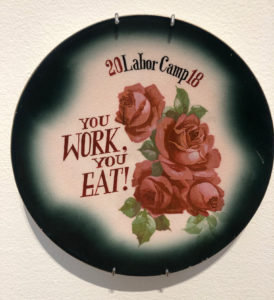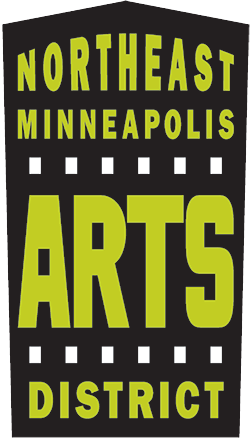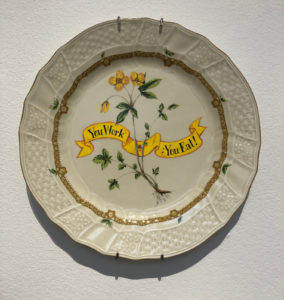What do Pablo Picasso, Joan Miro, Paul Gauguin, Marcel Duchamp, and Viola Frey all have in common? All were famous painters and sculptors who took a deep dive into the world of ceramics. MCAD professor and Casket Arts Studio artists Piotr Szyhalski steps into this realm with his latest museum show, the Weisman Art Museum’s (WAM) survey exhibition, PIOTR SZYHALSKI: WE ARE WORKING ALL THE TIME! “The show features work in a variety of media across three decades of Szyhalski’s prolific and pioneering practice, including poster design, web projects, mail art, painting, installation, and public performance. The exhibition will include artist-led “activations” in and around WAM, with moments of performance, printmaking, and in-gallery “office hours” by Szyhalski on select Fridays throughout the show’s run.” -WAM
One element in the show that is more subtle that many might not know the history of is the plate selection, called “You Work, You Eat 2019” enamel paint on found ceramic plates. “Using enamel paint, the artist transformed found porcelain decorative plates into a new version of his declarative posters.”

Painters and sculptors have a long history of dabbling and exploring ceramics in their careers. Many artists see ceramics as a craft, which it is. But are also drawn to the medium as it has a magical pull to the process. One debate at issue, can only painters and sculptors make fine art ceramic art or can ceramic artists make fine art too? Why are functional ceramics not considered art? Does it have to be touched by a “fine artist?” Or does it have to be placed in a museum, for it to be seen as produced by an artist?
There has been a huge shift in the world of ceramics since the 1960s where ceramicists in general were just starting their artistic pursuits, from ordinary ceramic ware to artist forms. Some early pioneers such as Peter Voulkos, Paul Soldner, Beate Kuhn, and Ron Nagle all broke out of the craftsman and utilitarian functionalism that had dominated the ceramic world for thousands of years. Now art and ceramics have been fused together in art school curriculums for many decades as ceramics tries to achieve “fine art” status. Still the debate is strong in all sections of the art community if ceramics is art or craft.
Szyhalski’s plates seem to be using the humble readymade plate as a vehicle to express propaganda and working-class values. The working class is not one of fancy indulgence. The plate represents our daily use of ceramics in everyday life with a political message printed on them. Does this now make ceramics art? Does it take a painter/printer/scuulptor to be able to turn ceramics into art or can a ceramics person create art? It has been a hotly debated topic in my ceramic studio many times. “Artists” rarely make the ceramics they paint or print on. But they seem to be drawn to the products and history they represent to make points and express ideas that most ceramic artists don’t explore. Sometimes having a collaboration of two artists can create unexpected new works. That is evident in Szyhalski’s plate works.
What is so gratifying about Piotr Szyhalski’s show is it showcases his vast interests in many mediums that involve the working class and politics. There are so many sub layers that his work brings out to talk about their history and where the materials’ original uses came from. How they have morphed into new meanings and uses. Duchamp’s readymade ceramic urinal kicked off this collaboration with art and ceramics. Ai Weiwei is at the forefront of using ceramics in his contemporary art. Piotr Szyhalski’s show continues and adds upon that dialog.
The exhibit opened August 20 and will be there through December 31; admission is free. There is a ticketed ($25) opening reception on Thursday, Sept. 15 from 7-9 p.m. The Weisman is at 333 East River Road, Minneapolis, MN 55455; parking in ramp under the museum.
The September 15 reservation link is HERE and the exhibit description is HERE.
The exhibition will include a number of artist-led “activations” in and around WAM, with moments of performance, printmaking, and in-gallery “office hours” by Szyhalski on select Fridays throughout the show’s run.
Analysis by Josh Blanc

